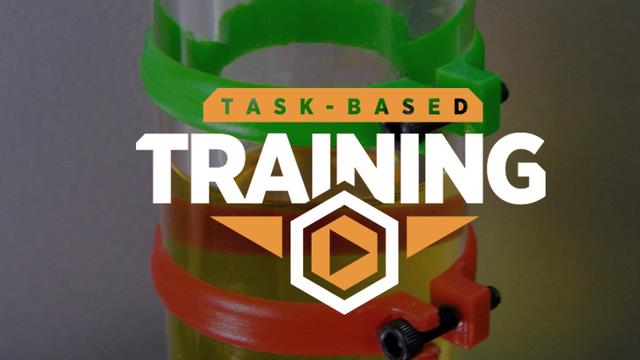Task-Based Training | Inspecting a Columnar Level Gauge
Tags: onsite oil analysis

What is a columnar level gauge?
A columnar level gauge is a type of sight glass. It is a tube made of clear material that, when installed on a machine, allows the oil to be seen and shows the oil level. These tubes are typically installed on a lower port or drain of a machine. Once installed, the tube is filled with oil.

Figure 1: A columnar level gauge filled with oil.
Why use a columnar level gauge?
A columnar level gauge provides a quicker and more insightful level reading than some of the other oil indicators like dipsticks, plugs, etc. Additionally, a columnar level gauge will allow some aspects of the lubricant’s condition to be inspected: these gauges allow inspectors to see particulates, debris, emulsified water, darkening oil or the formation of varnish.
Why inspect a columnar level gauge?
The sight glasses themselves must be inspected because they have the potential to become damaged or stained over time. Inspection of the sight glass should also focus on ensuring that the device is properly installed and functioning. Depending on how they are vented, columnar level gauges may not be reading or breathing properly, so they need to be checked regularly, especially when they are installed with breathers, tubes or valves.

Figure 2: A columnar level gauge installed with a desiccant breather.
When we are confident that the columnar level gauge is in working order, we can use it to inspect for early warning signs of machine or lubricant failure — previously mentioned issues like cloudiness, darkening oil, or the presence of particulates.
Where are they installed?
The lubricant storage component of most machines has several ports. When choosing where to install the columnar level gauge, you’ll want to select a port that is lower than the oil level. You’ll also want to make sure that the column extends slightly above the oil level. This allows the true oil level to be seen in the sight glass.

Figure 3: A columnar level gauge installed at the proper level.
It is also a good idea to implement a shut-off valve that can be used to quickly shut the port if the columnar sight glass breaks.

Figure 4: A columnar level gauge with a shut-off valve.
The top of the columnar level gauge can also be piped back into the headspace. This forms a closed loop and ensures any air the columnar is breathing has gone through the breather installed on the machine.

Figure 5: A columnar level gauge with a pipe leading to the machine’s headspace.
When you are installing a columnar sight glass, it is important to install it in such a way as to avoid trapping oil in the gauge. To avoid this, you’ll want to use as few fittings as possible and install the device straight onto the machine. Upward or downward bends in the pipe connecting the gauge to the machine will prevent the free flow of oil.

Figure 6: The bends in this pipe will trap oil in the gauge.
How do columnar level gauges work?
Columnar level gauges use fluid pressure from the oil to create an equilibrium, meaning that, as long as oil flow between the machine and the sight glass is unobstructed, the level of oil in the sight glass will be the same as the level in the machine.

Figure 7: An equilibrium between the lubricant in the machine and the lubricant in the sight glass.
Because fluid pressure alone is used to create an equilibrium in the lubricant levels, closed valves or plugged breathers can restrict the free flow of lubricant and air, making the gauge inaccurate.
Which levels should be marked?
Columnar level gauges should have two to three bands or marks identifying different oil levels. The first level to mark is the cold oil level; you’ll then want to measure and mark the oil level while the machine is running: this level may be higher or lower than the cold oil level. Finally, you will want to mark the critical oil level: the level that the oil should not drop below. Having this marked allows anyone walking by the machine to notice if the oil is too low and more oil is needed.
Who inspects columnar level gauges?
Typically, the operators, engineers and maintenance personnel are the ones inspecting these sight glasses. But because these sight glasses clearly indicate oil level, anyone walking by the machine can inspect it.
Inspecting a columnar level gauge
Step 1: Clean the surface of the level gauge with a lint-free industrial towel. Use a flashlight or laser pointer to illuminate the fluid within the sight glass.
Step 2: Check the oil level. It should fall between the “okay” level mark:

Figure 8: The “okay” level indicator.
And the “low/add” level mark:

Figure 9: The “low/add” level indicator.
Step 3: If the oil level is below the “low/add” mark, look for any signs of leaks, and report right away. If the oil is above the “okay” level mark, look for signs of water or process fluid ingression.
Step 4: Check the bottom of the columnar level gauge for particulates; look for signs of foam, and examine the oil color for cloudiness and darkening.
Step 5: Report any of the previously mentioned issues, as well as issues like abnormal temperature, vibration or noises.
Key Takeaways
- Ensure columnar level gauges are installed in easy-to-see locations.
- Ensure oil level indications are clearly marked.
- Inspect oil condition in addition to oil level.
- Record and track your findings.